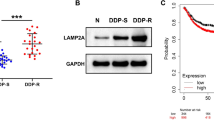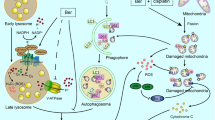Abstract
Accumulating evidence shows that microRNAs (miRNAs) have a critical role in the initiation and progression of types of human cancer, including breast cancer. Recent research indicated that miRNAs are also related with the chemotherapy on cancers. In this study, the expression of miR-221 in breast cancer (BC) patients’ serum and cancer tissues was found to be significantly up-regulated. The results of in vitro MTT assay indicated that although the anti-miR-221 oligonucleotide alone did not influence the viability of BC cell lines markedly, it significantly promoted the cytotoxicity of cisplatin (DDP) to BC cells. Mechanistic studies demonstrated that the gene of BIM (Bcl-2 interacting mediator of cell death), a pro-apoptotic Bcl-2 family protein, was up-regulated by the knockdown of miR-221. We found that the synergetic effect of anti-miR-221 on increasing the sensitivity of MDA-MB-231 was BIM dependant. Furthermore, results of immunoprecipitation showed the up-regulated BIM directly combined with the Bax and Bak, leading to mitochondrial dysfunction. Our results suggest the anti-miR-221 could promote the cisplatin-inducing apoptosis by targeting the Bim-Bax/Bak axis in breast cancer.






Similar content being viewed by others
References
Siegel R, Ma J, Zou Z, Jemal A. Cancer statistics, 2014. CA Cancer J Clin. 2014;64:9–29.
Matsen CB, Neumayer LA. Breast cancer: a review for the general surgeon. JAMA Surg. 2013;148:971–80.
Gradishar WJ. Treatment of metastatic breast cancer. J Natl Compr Cancer Netw. 2014;12:759–61.
Martin HL, Smith L, Tomlinson DC. Multidrug-resistant breast cancer: current perspectives. Breast Cancer (Dove Med Press). 2014;6:1–13.
Sorlie T, Perou CM, Fan C, Geisler S, Aas T, Nobel A, et al. Gene expression profiles do not consistently predict the clinical treatment response in locally advanced breast cancer. Mol Cancer Ther. 2006;5:2914–8.
Nana-Sinkam SP, Croce CM. Clinical applications for microRNAs in cancer. Clin Pharmacol Ther. 2013;93:98–104.
Gromak N. Intronic microRNAs: a crossroad in gene regulation. Biochem Soc Trans. 2012;40:759–61.
Ambros V. MicroRNA pathways in flies and worms: growth, death, fat, stress, and timing. Cell. 2003;113:673–6.
Esquela-Kerscher A, Slack FJ. Oncomirs—microRNAs with a role in cancer. Nat Rev Cancer. 2006;6:259–69.
Farazi TA, Hoell JI, Morozov P, Tuschl T. MicroRNAs in human cancer. Adv Exp Med Biol. 2013;774:1–20.
Cobleigh MA. Other options in the treatment of advanced breast cancer. Semin Oncol. 2011;Suppl 2:S11-16.
Srivastava A, Tiwari R, Srivastava V, Singh TB, Asthana RK. Fresh water cyanobacteria Geitlerinema sp. CCC728 and Arthrospira sp. CCC729 as an anticancer drug resource. PLoS One. 2015;10:e0136838.
Livak KJ, Schmittgen TD. Analysis of relative gene expression data using real-time quantitative PCR and the 2(−Delta Delta C(T)) method. Methods. 2001;25:402–8.
Prathapan A, Vineetha VP, Raghu KG. Protective effect of Boerhaavia diffusa L. against mitochondrial dysfunction in angiotensin II induced hypertrophy in H9c2 cardiomyoblast cells. PLoS One. 2014;9:e96220.
Wei MC, Zong WX, Cheng EH, Lindsten T, Panoutsakopoulou V, Ross AJ, et al. Proapoptotic BAX and BAK: a requisite gateway to mitochondrial dysfunction and death. Science. 2001;292:727–30.
Merino D, Lok SW, Visvader JE, Lindeman GJ. Targeting BCL-2 to enhance vulnerability to therapy in estrogen receptor-positive breast cancer. Oncogene. 2015.
Cory S, Adams JM. The Bcl2 family: regulators of the cellular life-or-death switch. Nat Rev Cancer. 2002;2:647–56.
Galardi S, Mercatelli N, Giorda E, Massalini S, Frajese GV, Ciafrè SA, et al. miR-221 and miR-222 expression affects the proliferation potential of human prostate carcinoma cell lines by targeting p27Kip1. J Biol Chem. 2007;282:23716–24.
Ali AY, Farrand L, Kim JY, Byun S, Suh JY, Lee HJ, et al. Molecular determinants of ovarian cancer chemoresistance: new insights into an old conundrum. Ann N Y Acad Sci. 2012;1271:58–67.
Wei HM, Qin SK, Yin XJ, Chen YL, Hua HQ, Wang L, et al. Inhibition and mechanism on combination of recombinant human endostatin and cisplatin in mouse model bearing S180 tumor ascite. Chin J Cancer Prev Treat. 2015;22:442–6.
Pace A, Savarese A, Picardo M, Maresca V, Pacetti U, Del Monte G, et al. Neuroprotective effect of vitamin E supplementation in patients treated with cisplatin chemotherapy. J Clin Oncol. 2003;21:927–31.
Hu J, Xu C, Cheng B, Jin L, Li J, Gong Y, Lin W, Pan Z, Pan C. Imperatorin acts as a cisplatin sensitizer via downregulating Mcl-1 expression in HCC chemotherapy. Tumour Biol. 2015.
Ou Y, Zhai D, Wu N, Li X. Downregulation of miR-363 increases drug resistance in cisplatin-treated HepG2 by dysregulating Mcl-1. Gene. 2015.
Adi Harel S, Bossel Ben-Moshe N, Aylon Y, Bublik DR, Moskovits N, Toperoff G, et al. Reactivation of epigenetically silenced miR-512 and miR-373 sensitizes lung cancer cells to cisplatin and restricts tumor growth. Cell Death Differ. 2015;22:1328–40.
Yin W, Nie Y, Zhang Z, Xie L, He X. miR-193b acts as a cisplatin sensitizer via the caspase-3-dependent pathway in HCC chemotherapy. Oncol Rep. 2015;34:368–74.
Wang X, He X, Hu S, Sun A, Lu C. Involvement of Bim in Photofrin-mediated photodynamically induced apoptosis. Cell Physiol Biochem. 2015;35:1527–36.
He H, Li DW, Yang LY, Fu L, Zhu XJ, Wong WK, et al. A novel bifunctional mitochondria-targeted anticancer agent with high selectivity for cancer cells. A novel bifunctional mitochondria-targeted anticancer agent with high selectivity for cancer cells. Sci Rep. 2015;5:13543.
Zhao L, Feng Y, Shi A, Zong Y, Wan M. Apoptosis induced by microbubble-assisted acoustic cavitation in K562 cells: the predominant role of the cyclosporin A-dependent mitochondrial permeability transition pore. Ultrasound Med Biol. 2015;41:2755–64.
Weber K, Harper N, Schwabe J, Cohen GM. BIM-mediated membrane insertion of the BAK pore domain is an essential requirement for apoptosis. Cell Rep. 2013;5:409–20.
Acknowledgments
This work was supported by Wenzhou Science and Technology Bureau (Grant numbers Y20100008)
Author contributions
GH designed the study. ZY wrote the manuscript. RH performed out the western blot and immunoprecipitation. ZY, YC, and XW carried out the cell culture and transfection, RT-PCR, and flow cytometry. All authors approved the final version of the manuscript.
Author information
Authors and Affiliations
Corresponding author
Ethics declarations
The study was approved by Ethic Committee of the First Affiliated Hospital of Wenzhou Medical University.
Conflicts of interest
None
Rights and permissions
About this article
Cite this article
Ye, Z., Hao, R., Cai, Y. et al. Knockdown of miR-221 promotes the cisplatin-inducing apoptosis by targeting the BIM-Bax/Bak axis in breast cancer. Tumor Biol. 37, 4509–4515 (2016). https://doi.org/10.1007/s13277-015-4267-4
Received:
Accepted:
Published:
Issue Date:
DOI: https://doi.org/10.1007/s13277-015-4267-4




